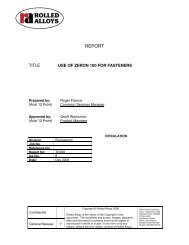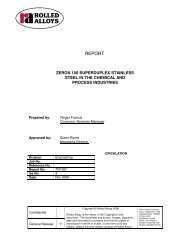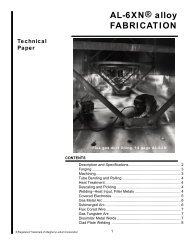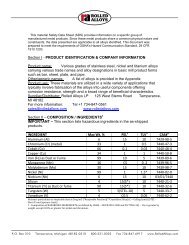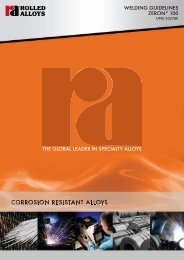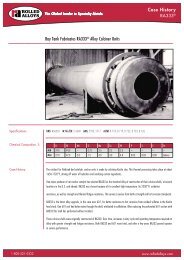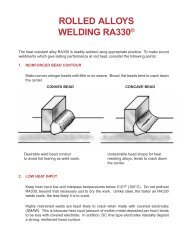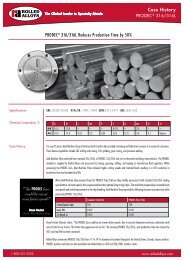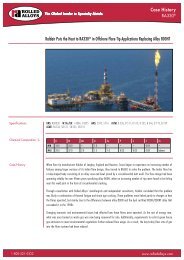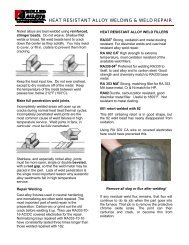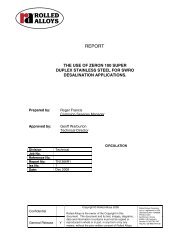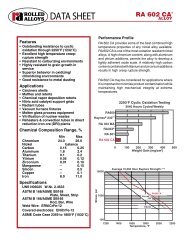ZERON 100 Mining Industry - Rolled Alloys
ZERON 100 Mining Industry - Rolled Alloys
ZERON 100 Mining Industry - Rolled Alloys
You also want an ePaper? Increase the reach of your titles
YUMPU automatically turns print PDFs into web optimized ePapers that Google loves.
MgSO 4 - 15g/lFe 2 (SO 4 ) 3 - 150 mg/lNaCl - 150, 17 or 1.7 g/lpH - 1,2 or 3The results in Table 4 show that at normal pH (3) the corrosion rate was low and even atpH2 the corrosion rate was still acceptable. However, at pH1 the corrosion rate was veryhigh and caustic injection or something similar would be required to prevent excessiveattack if this occurred in service. Samples were also included to test for crevice corrosionand stress corrosion cracking (SCC). Neither was observed. The direct injection ofsteam into the heater vessels increases the slurry volume by up to 10% and it has beenproposed that indirect heating of the slurry, in a series of heat exchangers, would bemore economical. This will depend on the price of steam for the particular project. Withindirect heating the slurry inside the tubes is no longer deaerated, and the risk ofcorrosion is greater.Independent laboratory tests to simulate the indirect heater environment (hightemperature, aerated slurry) showed that all stainless steels cracked at 200 o C. Only Ti-Ni(grade 12) and Ti-Pd (grade 16) resisted attack. Heating the slurry from ambient to200 o C requires a large number of heat exchangers in series and superduplex stainlesssteel is suitable for the first few stages where the temperatures are lower.3.2.2 Flash Tank FluidsThis environment, which is the spent liquor from the autoclave, is progressively cooledfrom 250 o C to ~ <strong>100</strong> o C. Acid concentrations are about 40 g/l with chlorides plussulphates of nickel and cobalt. Autoclave tests at 177 o C showed excessive corrosion ofalloy 20, 6% Mo austenitic and Zeron <strong>100</strong>. In addition the alloy 20 and 6% Mo austeniticwere pitting, and the C-rings showed severe cracking. Tests at different chloride levelsgave similar results and the corrosion seems to be controlled more by the acid content.These stainless steels are clearly unsuited for this environment.The exception to this was at <strong>100</strong>°C with 40 g/l acid . Zeron <strong>100</strong> corroded at a low rate(0.015mm/y max) with no localised corrosion or SCC with up to 5g/l chloride. With 20g/lchloride the corrosion rate increased (0.265mm/y) and pitting occurred.3.2.3 ThickenersAfter leaving the final flash tank at about <strong>100</strong> o C the slurry may be passed through a heatexchanger prior to separation of the solids and liquids in a series of thickeners. Thesehave long arms with rakes which are normally made of coated carbon steel. Bare metalis used for components such as hangers and pivots, which must be made of corrosionresistant alloys. Alloy 904L is sometimes used but in more aggressive environments thegreater corrosion resistance of Zeron <strong>100</strong> is required.The first thickener contains the most corrosive environment and tests were carried outunder the following conditions:CoSO 4 - 1.0 g/lFeCl 3 - 1.5 g/lNiSO 4 - 9.2 g/lCopyright © <strong>Rolled</strong> <strong>Alloys</strong> 2008Report No. TN1346Issue No. 4Page 8 of 22



